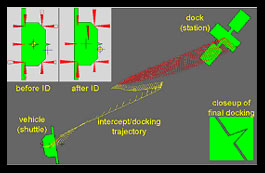|

Spacecraft
Docking
Simulation

Spacecraft
Docking Testbed

Software
Development Testbed
(click on image for larger view)
|
OBJECTIVES:
Increase
the safety, accuracy and efficiency of semi-autonomous / autonomous
spacecraft rendezvous and docking:
Neurocontrol
technologies that can learn in near real-time the mass property
of a spacecraft and its changes, and can compensate for thruster
strength degradation, thruster failures, and uncontrolled venting
(e.g. uncontrolled gas venting on Apollo 13 resulting from an onboard
explosion), will make semi-autonomous / autonomous spacecraft navigation,
rendezvous and docking safer, more accurate, faster, and more fuel
efficient. Moreover, docking to a moving target will be possible.
The
Smart Systems Research Lab at NASA Ames Research Center is developing
adaptive neurocontrol technologies to safely, accurately and efficiently
dock a spacecraft to a target under a wide range of difficult operating
conditions. The MIR accident that occurred is an example of the
kind of disaster that can take place if docking is not done optimally.
Difficult operational scenarios include 1) docking a spacecraft
when its thruster strengths are not well known, stuck or leaking,
2) docking a spacecraft whose mass property is not well known, 3)
rendezvous and capturing a disabled spinning satellite, 4) docking
a spacecraft to a spinning target, and (5) docking a spacecraft
when some of its sensors become inoperable or fail. Operating a
spacecraft under these conditions is a complex and dangerous task.
We are developing neurocontrol technologies to operate under these
difficult operating conditions, and are applying them in various
operational modalities, ranging from computer-aided joystick control,
semi-automated docking, and fully automated docking.
Conventional
automated docking approaches work well only when an accurate mathematical
model of the spacecraft is available. In the operational scenarios
described above, an accurate mathematical model is not available.
The approach being applied is to use advanced identification technologies
and adaptive neurocontrol to provide optimal control of the spacecraft.
These development efforts merge adaptive neural network technologies
with conventional feedback control techniques to handle problems
in system identification and control of nonlinear systems. This
approach does not require a mathematical model of the spacecraft
a priori but instead it effectively learns an accurate model of
the spacecraft from its behavior. The controller uses gathered data
from a set of navigational sensors to quasi-statically learn an
accurate model of the spacecraft performance. In this manner, the
controller can control the spacecraft under a variety of changing
conditions such as varying mass, changing center-of-mass location,
thruster degradations/failures, uncontrolled venting, and sensor
failures. Optimization methodologies are then used to achieve optimal
performance.
|